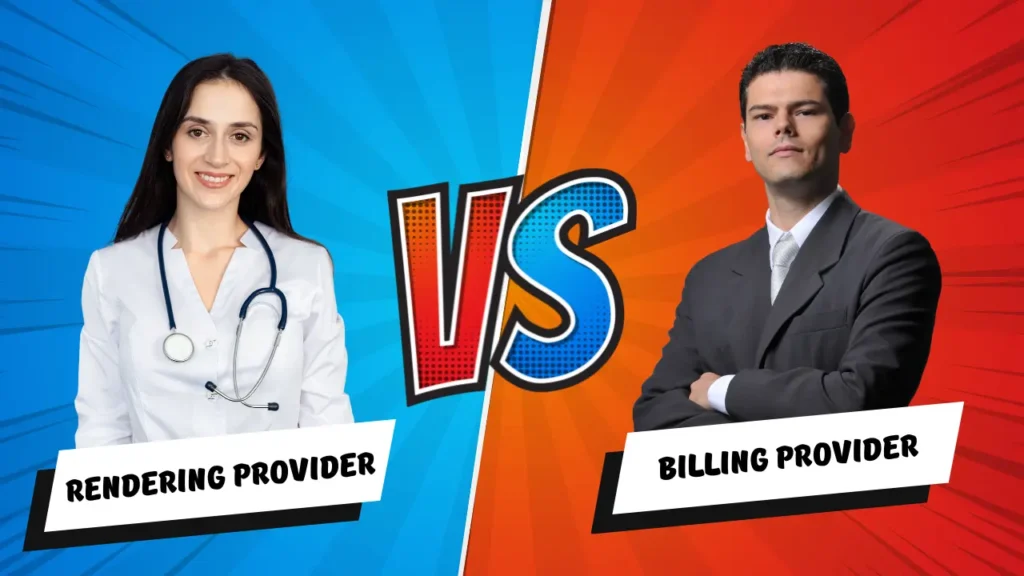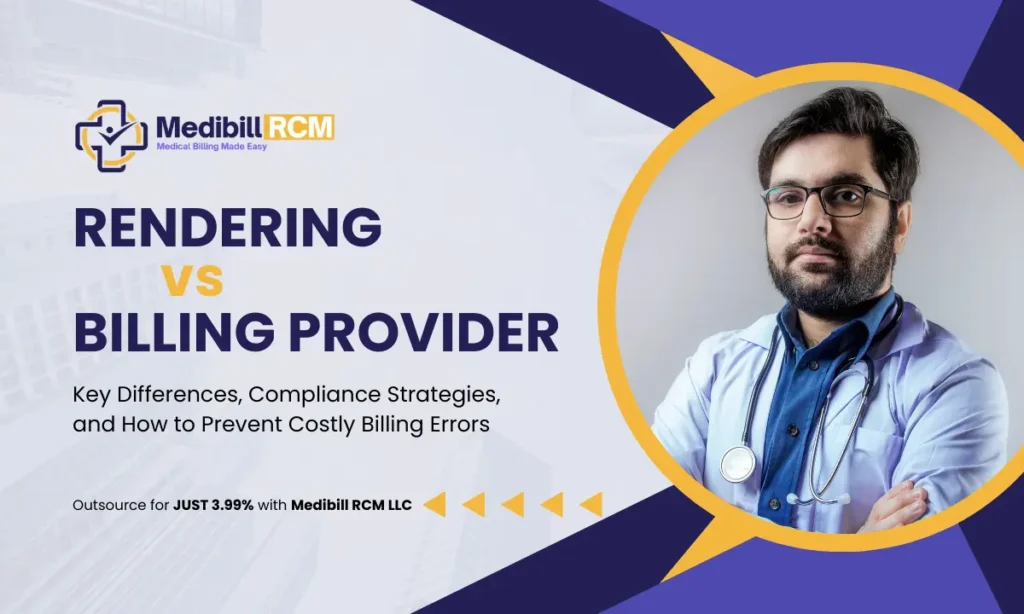Medical billing and healthcare reimbursement rely on accurate documentation and precise identification of provider roles. Two essential designations, Rendering Provider and Billing Provider, play distinct roles in the claims process. Confusing these roles can lead to claim rejections, compliance violations, and revenue loss.
This guide will break down the key differences, compliance requirements, and best practices for preventing costly billing errors.
Table of Contents
Why Understanding Provider Roles Matters in Medical Billing
Accurate provider identification is crucial for claim approval and reimbursement. Insurance payers, including Medicare, Medicaid, and private insurers, require precise provider classification to ensure proper compensation.
Failing to differentiate between a Rendering Provider (who delivers care) and a Billing Provider (who is responsible for submitting claims) can lead to:
- Claim denials or delays due to mismatched National Provider Identifier (NPI) numbers.
- Compliance violations include HIPAA and CMS (Centers for Medicare & Medicaid Services) penalties.
- Increased risk of audits, which may result in financial penalties or legal repercussions.
- Reputation damage, affecting trust with patients and insurance providers.
Understanding these roles ensures accurate billing, maintains compliance, and enhances the financial stability of healthcare organizations.
Struggling with claim denials and compliance issues? Outsource Medical Billing, Coding & Credentialing at Just 3.99%! Book Appointment Now.
Learn More About: Guide to National & State-Specific Insurance Payers with Credentialing Policies
Key Terms: Definitions and Context
Before diving deeper, here are essential terms in medical billing:
- Rendering Provider: The healthcare professional who delivers direct patient care (e.g., physician, nurse, therapist).
- Billing Provider: The entity or organization responsible for submitting claims (e.g., hospital, clinic, third-party billing service).
- National Provider Identifier (NPI): A unique 10-digit number assigned to healthcare providers for identification in billing.
- CMS-1500 & UB-04 Forms: Standard claim forms used for professional and institutional billing.
- Medicare & Medicaid Compliance: Regulations governing billing accuracy to prevent fraud and abuse.

What is a Rendering Provider?
A Rendering Provider is a healthcare professional who directly provides medical care to a patient. This role is crucial in diagnosing, treating, and documenting patient encounters to ensure proper claim submission.
Role and Responsibilities
Direct Patient Care
- Conducts examinations, diagnoses, and treatment plans for patients.
- Performs procedures, therapy, and medical interventions as necessary.
- Documents all services rendered in Electronic Health Records (EHRs).
Legal and Ethical Obligations
- HIPAA Compliance: Maintains patient confidentiality and secure handling of medical records.
- Licensure Requirements: Must hold valid state and federal licenses to practice medicine.
- Medical Necessity Documentation: Ensures treatments meet payer guidelines to justify reimbursement.
Examples of Rendering Providers
Rendering Providers include licensed healthcare professionals who provide direct, hands-on patient care in various settings:
Physicians
- General practitioners (GPs)
- Specialists (cardiologists, orthopaedic surgeons, dermatologists)
Nurses
- Nurse practitioners (NPs)
- Registered nurses (RNs)
- Certified nurse anesthetists (CRNAs)
Therapists
- Physical therapists (PTs)
- Occupational therapists (OTs)
- Speech-language pathologists (SLPs)
Other Healthcare Providers
- Chiropractors
- Physician assistants (PAs)
- Mental health professionals (psychiatrists, psychologists)

How Rendering Providers Impact Claim Accuracy
Since rendering providers are responsible for diagnosing and treating patients, their role directly affects medical billing accuracy and claim approval rates.
Here’s how they impact the billing process:
- Accurate Documentation:
- Diagnosis and procedure codes (ICD-10, CPT, HCPCS) must match the services provided.
- Improper coding can lead to claim rejections or audits.
- Proper NPI Usage:
- The Rendering Provider’s NPI must be correctly linked to claims for reimbursement.
- Mismatched NPIs are a leading cause of billing denials.
- Medical Necessity Compliance:
- Insurance payers require clear justification for treatments or procedures.
- Insufficient documentation can lead to claim denials and repayment demands.
- Timely and Correct Documentation:
- Delayed or missing documentation results in payment delays or denials.
- EHRs should integrate seamlessly with billing software to reduce errors.
By ensuring accurate documentation, proper NPI reporting, and compliance adherence, rendering providers reduce claim errors, prevent revenue loss, and support a smoother billing process.
Learn More About:
- 10 Common Reasons for Medical Billing Denials and How to Prevent Them
- Medical Coding Systems CPT, ICD-10, HCPCS Overview
What is a Billing Provider?
A Billing Provider is the individual, organization, or entity responsible for submitting medical claims and managing the financial aspects of healthcare billing. Unlike the Rendering Provider, who delivers patient care, the Billing Provider handles claim processing, insurance coordination, and financial oversight to ensure accurate and timely reimbursement.
Accurate identification of the Billing Provider is crucial for compliance with CMS, HIPAA regulations, and payer policies. Misidentification can lead to claim denials, audits, and financial penalties.
Role and Responsibilities
The key responsibilities include:
1. Claim Submission & Insurance Coordination
- Prepares and submits CMS-1500 (for professional services) or UB-04 (for institutional claims).
- Ensures CPT, HCPCS, and ICD-10 codes match the services provided.
- Coordinates with insurance companies, Medicare, and Medicaid to verify coverage.
2. Medical Coding Compliance
- Ensures that medical procedures, diagnoses, and treatments are coded correctly.
- Prevents upcoding (overbilling) and downcoding (underbilling) errors.
3. Financial and Administrative Oversight
- Monitors claims processing, reimbursements, and outstanding payments.
- Handles denials and appeals when payers reject claims.
- Ensures compliance with HIPAA, CMS, and payer-specific regulations.
4. Maintaining Accurate Provider Information
- The billing provider’s NPI must be correctly registered for all claims.
- Ensures that Rendering Provider NPIs are properly linked for claim validation.
5. Revenue Cycle Management (RCM) Optimization
- Implements Electronic Health Records (EHRs) and billing software for accuracy.
- Conducts internal audits to ensure compliance and prevent fraud.
- Works with medical coders and revenue cycle specialists to maximize reimbursements.
Examples of Billing Providers
The Billing Provider can be an individual or an organization, depending on the healthcare setting:
1. Healthcare Institutions
- Hospitals and medical centers (e.g., large health systems)
- Outpatient clinics and urgent care facilities
2. Private Medical Practices
- Solo or group physician practices
- Specialty clinics (e.g., dermatology, orthopedics, cardiology)
3. Third-Party Billing Services
- Medical billing companies that handle claim submissions for multiple providers
- Revenue Cycle Management (RCM) firms that manage end-to-end billing and collections
4. Government and Non-Profit Entities
- Community health centers (CHCs) and Federally Qualified Health Centers (FQHCs)
- State-run Medicaid agencies handling provider reimbursements

Each of these entities ensures that claims are processed correctly, payments are received, and compliance is maintained.
Learn More About: The benefits of Outsourcing Medical Billing Services
How Billing Providers Affect Revenue Cycles?
A Billing Provider’s efficiency directly impacts a healthcare organization’s financial health. The revenue cycle begins when a patient receives care and ends when the provider gets paid. If the Billing Provider fails to manage claims properly, it can disrupt cash flow, delay reimbursements, and increase compliance risks.
Here’s how Billing Providers influence the Revenue Cycle Management (RCM) process:
1. Reducing Claim Denials & Rejections
- Ensuring correct patient information, coding, and NPI details minimize errors.
- Proactively checking insurance eligibility prevents claim denials.
2. Improving Cash Flow & Timely Reimbursements
- Efficient claim submission and follow-ups reduce payment delays.
- Using automated billing systems and clearinghouses ensures faster processing.
3. Minimizing Compliance Risks
- Correctly differentiating Rendering vs. Billing Provider roles avoids fraud allegations.
- Regular internal audits and coding reviews prevent overbilling penalties.
4. Enhancing Financial Stability
- Identifying and resolving underpayments ensures maximum reimbursement.
- Strategic denial management improves long-term revenue collection.
By streamlining billing workflows, staying compliant, and leveraging technology, Billing Providers play a critical role in ensuring healthcare providers receive complete and timely payments for their services.
Rendering Provider vs Billing Provider: Key Differences

Functional Differences
| Aspect | Rendering Provider | Billing Provider |
|---|---|---|
| Role | Delivers direct patient care (diagnosis, treatment, documentation). | Manages claim submission, coding, and reimbursement processes. |
| Focus | Clinical (medical treatment and patient health). | Administrative (billing, financial tracking, compliance). |
| Common Professions | Physicians, nurses, therapists, specialists. | Hospitals, clinics, third-party billing agencies. |
| Claim Involvement | Provides service details but does not submit claims. | Ensures claims are correctly coded and submitted to payers. |
| Key Impact | Determines medical necessity and ensures proper documentation. | Ensures proper coding and payment collection. |
Legal and Compliance Differences
| Aspect | Rendering Provider | Billing Provider |
|---|---|---|
| Legal Responsibility | Must follow medical licensure laws and HIPAA. | Must follow CMS, HIPAA, and fraud prevention regulations. |
| Compliance Risks | Errors in documentation can lead to malpractice claims. | Billing errors can lead to audits, fraud investigations, and financial penalties. |
| HIPAA Obligations | Ensures patient confidentiality and accurate records. | Ensures secure billing transactions and compliance with payer policies. |
| Common Legal Issues | Failure to document properly, unlicensed practice, misdiagnosis. | Upcoding, unbundling, incorrect claim submissions, overbilling. |
Operational Differences
| Aspect | Rendering Provider | Billing Provider |
|---|---|---|
| NPI Type | Individual NPI assigned to a licensed healthcare provider. | Organizational or Group NPI used for billing purposes. |
| Documentation Responsibility | Records diagnoses, treatments, and medical necessity in EHRs. | Ensures billing codes align with documented services. |
| Technology Used | Electronic Health Records (EHR) for patient documentation. | Billing & Revenue Cycle Management (RCM) software for claim submission. |
| Financial Impact | Affects claim approval by providing accurate medical records. | Affects cash flow & reimbursement timelines through efficient billing. |
| Errors & Consequences | Mistakes lead to denied claims, malpractice suits, or audits. | Errors cause claim rejections, financial penalties, or fraud allegations. |
Side-by-Side Comparison
| Factor | Rendering Provider | Billing Provider |
|---|---|---|
| Definition | Healthcare professional providing direct patient care. | Entity or organization responsible for billing and reimbursement. |
| Primary Role | Diagnosis, treatment, and documentation. | Coding, claim submission, and revenue management. |
| Common Professions | Doctors, nurses, therapists, specialists. | Hospitals, private clinics, billing companies. |
| Compliance Focus | HIPAA, patient confidentiality, proper documentation. | CMS, HIPAA, fraud prevention, revenue cycle optimization. |
| Errors & Risks | Missed documentation, incorrect diagnosis coding. | Incorrect billing, upcoding, compliance violations. |
Why the Distinction Matters in Healthcare
The difference between a Rendering Provider and a Billing Provider is critical because it directly affects claim accuracy, reimbursement, compliance, and overall revenue cycle management. Misidentifying these roles can lead to claim denials, payment delays, audits, and legal penalties.
Understanding this distinction ensures:
✅ Accurate Claim Processing – Prevents rejections due to mismatched provider NPIs.
✅ Regulatory Compliance – Adheres to CMS, HIPAA, and payer-specific rules.
✅ Financial Stability – Ensures timely and full reimbursements.
✅ Fraud Prevention – Reduces risks of billing errors or fraudulent claims.
Clear differentiation between these roles is essential for healthcare providers, billing teams, and administrative staff to maintain efficiency and compliance in medical billing.
Reduce Billing Errors & Improve Compliance! Our Expert Team Ensures Accurate Provider Role Identification – All at Just 3.99%! Book Appointment Now.
Common Challenges When Roles Are Confused
Confusing the roles of the Rendering Provider and Billing Provider can lead to serious financial, operational, and compliance issues. Here are the most common challenges that arise when these roles are not adequately distinguished:
1. Claim Rejections and Denials
- Mismatched NPI numbers between Rendering and Billing Providers can trigger automatic claim denials.
- Incorrect provider classification can lead to non-payment from insurers and require re-submission.
2. Delayed Payments and Cash Flow Disruptions
- Rejected or incorrectly processed claims slow down reimbursements, affecting cash flow.
- Billing disputes with insurance companies can lead to further delays and administrative burdens.
3. Increased Risk of Audits and Fines
- Regulatory bodies like CMS and private insurers conduct audits to identify improper billing practices.
- Misidentifying providers may result in HIPAA violations, fraud investigations, or financial penalties.
4. Reputational Damage and Patient Trust Issues
- Billing errors can lead to overcharges or denied insurance coverage for patients.
- Repeated issues with claim processing can harm a healthcare provider’s reputation and trustworthiness.
To prevent these challenges, healthcare organizations must implement proper training, provider verification protocols, and automated billing systems to ensure accuracy and compliance.
Best Practices to Avoid Confusion
To prevent errors and ensure accurate billing, healthcare organizations must follow structured best practices when distinguishing between Rendering Providers and Billing Providers. Here’s how to avoid confusion:

1. Accurately Identify Providers in Claims
- Ensure the Rendering Provider’s NPI is listed correctly for direct patient care.
- Confirm that the Billing Provider’s NPI matches the entity submitting the claim.
- Double-check that provider credentials and taxonomy codes align with claim requirements.
2. Train Staff and Providers on Billing Rules
- Conduct regular training sessions for billing teams, coders, and administrative staff.
- Educate providers on proper documentation to prevent claim mismatches.
- Keep up with Medicare, Medicaid, and private payer guidelines on provider roles.
3. Leverage Technology for Accuracy
- Use Electronic Health Records (EHRs) and practice management software to auto-fill provider information correctly.
- Implement billing software with built-in compliance checks to flag errors before submission.
- Regularly update provider databases and NPI registry information.
4. Conduct Regular Audits and Compliance Checks
- Perform routine internal audits to ensure provider roles are correctly assigned.
- Cross-check claims before submission to catch mismatched NPIs or missing details.
- Maintain detailed records to support claim accuracy in case of payer audits.
By implementing these best practices, healthcare organizations can reduce claim rejections, ensure compliance, and streamline their revenue cycle management.
Legal and Regulatory Implications

Misidentifying Rendering Providers and Billing Providers can lead to serious legal and compliance issues. Regulatory agencies like CMS (Centers for Medicare & Medicaid Services), HIPAA, and private insurers enforce strict rules to prevent fraud, abuse, and improper billing. Here’s how these regulations apply:
1. CMS Guidelines for Provider Identification
- CMS requires that claims clearly differentiate between the Rendering Provider (who performed the service) and the Billing Provider (who is receiving reimbursement).
- Incorrect NPI usage can result in claim denials, audits, or payment recoupments.
- Medicare and Medicaid audits focus on ensuring that services billed match provider credentials.
2. HIPAA Violations and Penalties
- HIPAA (Health Insurance Portability and Accountability Act) mandates the protection of patient and provider data, including correct provider identification.
- Improper billing due to misidentification can lead to compliance violations and penalties ranging from $100 to $50,000 per violation, depending on severity.
3. Fraud Prevention and Anti-Kickback Regulations
- Knowingly misrepresenting a provider on claims can be considered healthcare fraud, leading to criminal charges, fines, or exclusion from federal programs.
- The False Claims Act (FCA) allows the government to recover three times the amount of improper payments plus additional penalties.
- The Anti-Kickback Statute prohibits improper financial relationships between Rendering and Billing Providers to prevent fraudulent referrals.
4. State-Specific Regulations
- Some states have additional billing and provider identification rules beyond federal laws.
- Medicaid programs vary by state, and incorrect provider information may result in state-imposed penalties or loss of provider eligibility.
Frequently Asked Questions (FAQ’s)
Can a billing provider submit claims without a rendering provider?
No, a Rendering Provider must be listed on claims for services that involve direct patient care. A Billing Provider alone cannot bill for clinical services without specifying who performed them.
What happens if the rendering provider’s NPI is incorrect on a claim?
The payer will likely deny or reject the claim. To avoid payment delays, it must be corrected and resubmitted with the proper NPI.
Can a provider have multiple NPIs for different roles?
Yes, if a provider operates in different specialties or locations, they may have multiple NPIs. However, each NPI must be correctly linked to the appropriate services and billing entity.
How do group practices handle rendering and billing provider roles?
In a group practice, individual Rendering Providers bill under their own NPI, while the practice entity (or owner) serves as the Billing Provider, submitting claims on behalf of all providers.
Can an incorrect billing provider lead to compliance issues?
Yes, using the wrong Billing Provider can trigger fraud investigations, claim audits, and financial penalties under CMS and HIPAA regulations.
Tools and Resources
To ensure accurate billing, compliance, and efficient claim processing, healthcare providers and billing professionals can leverage the following tools and resources:
1. Checklist for Accurate Provider Identification
✅ Verify that the Rendering Provider’s NPI matches the provider delivering care.
✅ Confirm that the Billing Provider’s NPI is registered correctly with payers.
✅ Ensure coding (CPT, HCPCS, ICD-10) aligns with provided services.
✅ Regularly update provider enrollment records with Medicare, Medicaid, and private insurers.
2. Glossary of Medical Billing Terms
- Rendering Provider: The provider who delivers direct patient care.
- Billing Provider: The entity responsible for claim submission and payment processing.
- NPI (National Provider Identifier): A unique 10-digit identifier for healthcare providers.
- CMS-1500 & UB-04 Forms: Standard claim forms used for professional and institutional billing.
- Modifier Q6: Indicates services provided by a locum tenens (substitute) provider.
3. Recommended Software for Streamlined Billing
🖥 Electronic Health Record (EHR) Systems
- Epic – Comprehensive EHR with integrated billing.
- Cerner – Streamlines documentation and claim submission.
📊 Medical Billing & Revenue Cycle Management Software
- Kareo – Ideal for small practices and independent providers.
- Athenahealth – Cloud-based billing with AI-driven compliance checks.
- eClinicalWorks – End-to-end practice management with automated billing.
🔍 Claim Scrubbing & Compliance Tools
- Availity – Real-time claims management and eligibility verification.
- Optum360 EncoderPro – Ensures accurate coding and billing compliance.
Take the stress out of medical billing! Cut Costs & Boost Revenue by outsourcing to our expert team for just 3.99%. Schedule a Free Call!
Learn More About: Top 10 EHR and Billing Software for Solo Practitioners in the USA
Conclusion
Accurately distinguishing between a Rendering Provider and a Billing Provider is essential for proper claim processing, compliance, and financial stability in healthcare. Misidentifications can lead to claim denials, audits, delayed payments, and regulatory penalties.
By implementing best practices, leveraging technology, and conducting regular compliance checks, healthcare providers and billing teams can streamline the billing process, reduce errors, and maximize reimbursements.
Final Takeaway:
✅ Ensure correct provider identification on all claims.
✅ Stay compliant with CMS, HIPAA, and payer regulations.
✅ Utilize EHR and billing software to prevent errors.
✅ Conduct regular audits to avoid costly mistakes.
Learn More About: Why Insurance Credentialing for US Healthcare Providers is Crucial


